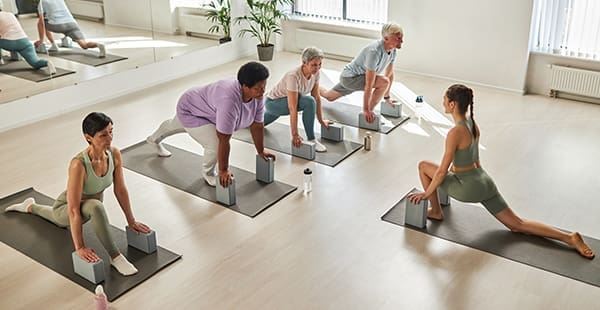Why Do Mesothelioma Experts Recommend Yoga for Cancer Patients?
The varied benefits of yoga make it a popular recommendation from cancer specialists. Yoga is a mind-body practice that combines movement, breath and mindfulness. It generally helps center and relax practitioners while improving strength and flexibility. Yoga has many different styles, making it customizable and approachable for anyone.
Beyond these general benefits, research shows that yoga can offer cancer-specific ones too. When used as a complementary therapy, it may help with symptoms and side effects. Benefits include less fatigue and pain, better sleep and improved quality of life. Studies also show yoga may significantly help with the mental and emotional toll of cancer.
For example, a 2024 research review looked at 18 studies on yoga for people in cancer treatment. It found yoga effectively reduced fatigue, improved sleep quality and helped manage negative emotions. This is just one of many studies with similar findings.
Leading cancer groups recommend yoga as a supportive care option. Cancer groups include the American Society for Clinical Oncology (ASCO) and the Society for Integrative Oncology (SIO). Their 2023 guidelines recommend yoga to help ease various cancer symptoms.
Despite what is often shown online, yoga has many styles and difficulty levels. Styles range from gentle and restorative practices to more active and vigorous ones. A cancer yoga program should be tailored to a patient’s energy level, cancer stage and treatment plan.
List of Potential Benefits of Yoga for Cancer Patients
Many cancer patients and survivors have reported positive benefits from yoga. These benefits are often palliative, which is a form of medical care aimed at boosting patient comfort. Studies are ongoing, but so far, the results are encouraging for something relatively easy to implement.
Potential benefits of yoga for mesothelioma cancer patients include:
- Better sleep quality: Evidence shows yoga may help patients fall asleep faster and stay asleep longer. Cancer patients who do yoga also tend to use fewer sleep medications.
- Greater balance, strength and flexibility: Even gentle, low-intensity yoga can build physical resilience, balance and mobility. Flexibility and mobility help you stretch and move comfortably. Research shows that even light physical activity, like yoga, may improve response to treatment and survival.
- Improved quality of life: Yoga can improve both mental and physical health. It may also increase comfort and enjoyment of day-to-day activities.
- Less fatigue and pain: Studies have shown that yoga may boost energy, reduce cancer-related tiredness and ease muscle tension or discomfort. Mesothelioma pain and fatigue are common symptoms for patients, so this may be very helpful.
- Lowered stress levels: Some research has found that yoga’s relaxation practices may lower stress markers.
- Reduced anxiety and depression: Living with cancer can cause feelings of anxiety and depression. Yoga has been effective in helping to alleviate these mood imbalances.
Some studies suggest yoga may help with nausea, vomiting, night sweats and sexual dysfunction. It may also ease thinking and memory problems, often called chemo brain. This evidence is more limited, but patients may still see some of these benefits.
Researchers have also highlighted yoga’s unique accessibility and adaptability. One study noted several factors that make the practice relatively easy. Yoga classes can be tailored to your needs and schedule. You can also practice yoga in a clinical setting, a group class or at home solo. Many options are available, often at little or no cost.
If you’re interested in yoga, it’s crucial to always talk with your care team first. They can confirm if it’s safe and aligned with your mesothelioma treatment plan. They can also help adapt yoga to your needs or recommend a qualified teacher who can.
Resources for Mesothelioma Patients
What Are the Best Kinds of Yoga for Cancer Patients?
Yoga has been practiced for thousands of years, and styles are still evolving. You can choose from countless types of practices. Each person with cancer is unique, so there is no one-size-fits-all yoga approach. But some methods may generally be a better fit for people with cancer, like mesothelioma.
Experts often recommend that cancer patients generally focus on gentle, low-impact yoga styles. These styles are designed to support recovery and healing, not push physical limits. Your care team may have specific styles or instructors in mind for you, too.
Several forms of gentle yoga for cancer patients are popular. They share an emphasis on slower movement, breathwork and relaxation. Many are available both in-person and virtually. Gentle yoga styles often recommended for cancer patients include:
- Chair yoga is a slow, calm style that uses a chair for balance and seated postures (asanas). Chair yoga for cancer patients boosts accessibility for those with fatigue or limited mobility. It can be guided, or patients can perform their favorite poses at home anytime.
- Hatha yoga is a traditional approach to a guided, physical yoga practice. Classes are typically not heated and move at a slow to medium pace. Students move through asanas that are held for about 5 – 10 breaths. ASCO/SIO guidelines mention this style.
- Restorative or therapeutic yoga are similar styles that emphasize long stretches, easy poses and deep rest. Very calming and slow, students often stay in each asana for several minutes. Props students can use for comfort include yoga blocks, bolsters, eye masks and pillows. This style is mentioned in the ASCO/SIO guidelines.
- Yin yoga is a slower, “cooler” (rather than physically warming) practice. It focuses on deep stretches and relaxation rather than vigorous flows. Seated poses are held for roughly 45 seconds to several minutes. Yin encourages stillness and allows gravity to do most of the work.
Patients may also consider a specialized type of yoga for cancer, called Yoga4Cancer (Y4C). This method is designed specifically for people undergoing or recovering from cancer treatment. While you can always tailor a yoga style to suit you, this may be a good fit as-is.
Are There Kinds of Yoga Cancer Patients Should Avoid?
No yoga style is ultimately off limits for cancer patients, especially if you already have an established practice. With your doctor’s approval, any type of yoga can be modified to your energy and ability. However, experts recommend gentler yoga styles for cancer patients and have key points for choosing a practice.
Patients generally want to avoid more vigorous “yang” styles, unless cleared by a cancer specialist and modified. Popular yang styles include ashtanga, Bikram, hot yoga, kundalini, power yoga and vinyasa flow.
MD Anderson Cancer Center warns cancer patients about the risks of extreme heat. Staying hydrated is already difficult because of the cancer and its treatment. Heated yoga classes may lead to excessive dehydration that is harder to combat.
One study highlights other precautions that are relevant to mesothelioma. If the cancer affects the lungs or chest (like pleural mesothelioma), patients may have higher risks of breathing complications. Deep or intense breathing exercises in some yoga practices may lead to lung collapse. This is especially true for patients with pleural effusion, recent surgeries or those receiving chest radiation.
Where Can I Find Yoga Classes for Cancer Patients?
Cancer patients have many ways to find the right yoga program. These options can primarily be categorized as:
- Programs specifically created for people with cancer
- General studio classes that can be self-modified to be appropriate for cancer patients
- In-person classes at cancer centers and hospitals
- Virtual or private classes that allow you to practice from home
Virtual Yoga Oncology Classes for Mesothelioma Patients
Several health organizations have online yoga oncology classes for cancer patients. The instructors are specifically trained to adapt the practice for cancer patients. The practice is gentler and usually offers many ways to modify poses.
Top resources for virtual yoga oncology classes include:
- Christina Phipps Foundation: Free oncology yoga classes several days each week on Zoom®
- El Camino Health: Free weekly online yoga and meditation class for cancer survivors and caregivers
- Yoga4Cancer: Online platform with a library of pre-recorded yoga classes designed for cancer patients and survivors
Taking In-Studio Yoga Classes With Mesothelioma
You can also find group classes at most yoga studios. The classes aren’t usually cancer-specific, so you might choose gentler styles and modify as needed. Attending in person can provide encouragement, connection and more personalized instruction.
Easy ways to find in-person yoga classes include:
- Google Maps®, Apple Maps® or Yelp®: You can search for local yoga studios or for specific styles, such as yin yoga.
- MindBody®: With the MindBody website and app, you can search for and book yoga classes at many studios. The app is available for Apple® and Android® users.
- Momence®: This app is similar to MindBody but offers a smaller selection of studios. The app is available for Apple and Android users.
Be sure to get medical approval for group fitness classes first. Enclosed spaces can pose health risks for immunocompromised patients. Outdoor yoga classes may be a preferable option, as better airflow can reduce risks to your health. Indoor options may be safer if classes are spacious and well-ventilated. You might want to wear a face mask to help reduce infection risks.
Specialized Yoga Classes at Cancer Facilities
For highly individualized guidance, your cancer center might have certified yoga therapists. Specialized instructors know how to adapt practices for factors like treatment side effects, limited mobility and fatigue. If your cancer center doesn’t offer this benefit, others in the area might.
The best way to find out is by talking with your care team. They can explain what’s available or direct you to other cancer centers or hospitals. You can also search online for “cancer center with yoga” for local results. Adding specific city names can search other areas, too.
Virtual or Private Yoga Classes for Mesothelioma Patients
Most yoga studios also offer private sessions, often both in their studio or at your own home. These options allow for fully individualized instruction. Private classes may feel more approachable than group ones. At the same time, they offer hands-on guidance.
To find private yoga classes, you can first search for studios in your area. Because private classes are so personalized, it might be best to email or call several studios. After explaining your needs, they can determine which teacher might be best suited to help you. They can also go over pricing, private class locations and other details.
Similarly, virtual yoga classes may feel more approachable than in-person ones. Various online platforms offer free, beginner-friendly yoga videos. You can search classes by styles, difficulty levels and more. Top online yoga resources include:
You can also use MindyBody and Momence to find many types of virtual classes.
Yoga Tips for Mesothelioma Patients
In general, yoga is relatively safe when practiced with a qualified instructor. Cancer patients should take extra precautions to avoid injury, illness and overexertion. When practicing yoga as a cancer patient, experts recommend:
- Choosing gentle yoga styles instead of vigorous, high-intensity classes (unless cleared by your doctor)
- Skipping challenging postures unless you’re certain they’re safe for you
- Starting slow and increasing intensity if it feels right for you
- Staying hydrated, especially if practicing in a warm environment
- Stopping right away if a posture causes pain or makes breathing difficult
- Taking rest or modifying whenever needed, even if the teacher hasn’t called out to do so
- Telling your instructor about your diagnosis, treatment stage and any other medical issues so they can help modify poses
- Waiting two or more hours after eating to practice yoga
- Working with a qualified teacher first before practicing alone at home
Ultimately, you want to ensure yoga supports your recovery rather than adds unnecessary strain. In addition to the above tips, it’s important to avoid pushing yourself too hard. But how do you know where that line is?
The Himalayan Yoga Institute notes that “at the end of a practice session, you should feel relaxed and invigorated – not exhausted.” For mesothelioma patients, exhaustion may set in more easily. This is one reason less-demanding classes may be a better fit.
Lastly, remember to always check with your healthcare team before starting or changing your yoga routine. Yoga can be a helpful form of self-care for patients and may ease some cancer symptoms or treatment side effects. But to get the most out of it, medical guidance is key.
Common Questions About Yoga and Cancer Patients
- What type of yoga is best for cancer patients?
Experts often recommend gentle, low-impact yoga for cancer patients. Popular yoga styles for cancer include restorative yoga, chair yoga and yin yoga. These styles can be tailored to energy level and treatment stage. No matter the style, always consult your doctor before starting.
- Should cancer patients practice virtual or in-person yoga?
Both virtual and in-person yoga classes may be suitable for cancer patients. In-person classes offer more guidance, while virtual classes are convenient and reduce risk of exposure to germs. Choose what fits your health, comfort and energy. Doctors can help you decide which is best and provide some resources.
Disclaimer: Cancer patients should check with their doctors before starting any new movement practices.











